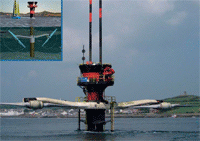
After more than 20 years of abandoned studies, backtracking and buck-passing, the UK government is finally poised to make a decision on exploiting the vast potential of the Severn Estuary.
Five schemes - an assortment of barrages and lagoons that impounds the water at high tide and sends it rushing through hydroelectric turbines when the waters recede - are on the current short list and a decision on whether to go ahead with any of these is expected next summer.
The most high profile of these options is the so-called Severn Barrage: a 10-mile (16km)-long concrete dam running from Lavernock Point near Cardiff to Brean Down near Weston-super-Mare. However, while proponents of the scheme claim that it could generate up to five per cent of the UK’s electricity requirements, the likelihood of it being given the green light appears to be receding. Critics claim that it will impinge on shipping and have a disastrous impact on the local environment, while a recent report in The Times quoted Whitehall insiders as saying that the £23bn project will be shelved under a cost-cutting drive.
Testing the waters
The top five contenders for Severn Tidal Generation
- Cardiff-Weston Barrage 8.46GW scheme, commonly known as the ‘Severn Barrage’, with an estimated cost of construction of £20.9bn
- Shoots Barrage 1.05GW scheme downstream of the new Severn road crossing, with an estimated construction cost of £3.2bn
- Beachley Barrage 625MW scheme further upstream of the first Severn road bridge, with an estimated cost of construction of £2.3bn
- Bridgwater Bay Lagoon 1.36GW impoundment on the English side of the estuary, with an estimated construction cost of £3.8bn
- Fleming Lagoon 1.36GW impoundment on the Welsh bank of the estuary with an estimated construction cost of £4bn
Against this backdrop, £500,000 of government funding has been allocated for the development of lower-cost, less intrusive technologies considered too embryonic to make it onto the original short list.
Jamie O’Nians, head of marine at renewables specialist IT Power, believes that, with the right backing, these early-stage technologies could leapfrog the current favourites and begin providing significant power to the grid by 2020.
O’Nians, who is heading up a consortium of Edinburgh University, Metoc and Sigma Offshore, is currently developing plans for a tidal fence: a line of hundreds of carefully positioned underwater tidal current turbines that would harvest the energy from the water that flows in and out of the Severn without impounding huge volumes of water. IT Power estimates that the scheme would cost around £3.5bn to build and could have a capacity of up to 1.3GW - more than the Sizewell B nuclear power station.
O’Nians believes that the system could address many of the concerns relating to some of the other proposals. ‘It turns out that there can be quite significant environmental impacts relating to lagoons and more directly into barrages damming across the estuary in its fullness,’ he said. ‘It’s a huge concern and quite difficult to assess. You don’t know what it’s going to be like, but what you do know is it will fundamentally change.’
O’Nians added that a porous tidal fence would also have a minimal impact on shipping, which is another area of concern with the bigger schemes. ‘Our understanding is that the Bristol port authority - which is a very significant port in the UK - is really quite concerned about barraging because it would impinge on their business,’ he said.
In terms of the core technology, while around 50 different tidal stream turbines have been proposed, only one device - Seagen’s 1.2MW turbine - has been demonstrated on a significant scale. However, even this is a single standalone device. No-one has yet deployed an array of tidal stream generators and a Severn fence would require up to 800 of them.
O’Nians is undaunted. ‘It’s the kind of thing that could bring about the step change that the tidal current market needs,’ he said. ‘There would be a relatively long lead in time and I think there’s the manufacturing capability to do it… It’s a project that could be comfortably achieved before 2020.’
However, while a scheme such as the Severn Barrage could comfortably generate vast amounts of power, O’Nians admitted that getting the most out of a tidal fence will require a delicate balancing act. Indeed, to provide a really significant amount of energy, the system will have to constrain the estuary to some degree.
‘There’s an upper limit to the amount of energy that could be captured in the Severn Estuary by tidal stream generators that is way short of what a barrage might do,’ he said. ‘The study is now about where we can maximise energy extraction but still allow free unconstrained navigation by the significant shipping that goes up and down the estuary - that’s the key requirement. We could go for a semi-constrained or even a fully constrained option where we would get much higher energy yields, but it’s at the disadvantage of navigation. If you take a pure kinetic device, you may get 300-400MW. If you also start utilising the pressure differential - the tidal range - you can significantly enhance that, but there is a cost because you introduce a head difference, which means you introduce more difficulties for fully unconstrained navigation, so the test is to say where we will end up being in terms of utilising that pressure differential.’
‘We can’t not utilise the resource in the Severn; that’s unthinkable given the climate imperative we have these days’
Jamie O’Nians
IT power
Meanwhile, the government is considering its existing short list of options and is due to make a decision next year on which, if any, to pursue.
O’Nians is keeping an open mind. ‘I’ll be perfectly candid about it,’ he said. ‘There is a very strong call towards putting in a scheme that will provide five per cent of UK electrical generation for a very long time. From a strategic energy generation perspective, that’s pretty significant, which is why it’s worth considering even though it has a high capital cost, a long lead in time and very significant environmental impact.
‘But I think pragmatically it’s going to be quite difficult to convince people that the environmental impacts are going to be acceptable,’ added O’Nians. ‘The fence undoubtedly compromises on energy yield. We’re trying to do something that won’t be of the same magnitude but will be far more acceptable in terms of the key stakeholders.’
While a go-ahead for the Severn Barrage would blow the fence out of the water, there are numerous other options on the table, including smaller barrages and tidal lagoons, which, according to O’Nians, do not spoil the opportunity for taking energy out in different ways. ‘The big barrage is an all-or-nothing option, whereas there are other solutions that are complementary,’ he said.

Indeed, the IT Power consortium is not alone. Offshore energy company VerdErg has developed an alternative concept for a tidal fence, which generates electricity by exploiting the pressure difference to drive water through an array of vertical and horizontal tubes. Meanwhile, Rolls-Royce and WS Atkins have joined forces on the development of a so-called tidal reef, a kind of low-impact barrage.
O’Nians appears to welcome this competition and, taking a step back from his own scheme, claimed that, whatever happens, the vacillation that has defined the decades-long debate over the Severn must end now. ‘We can’t not utilise the resource in the Severn; that’s unthinkable given the climate imperative we have these days,’ he said. ‘We can’t let a localised environmental impact stop us from doing something that’s going to have a macro-effect on CO2 offsetting. Doing nothing is a far greater risk than doing something.’




Swiss geoengineering start-up targets methane removal
No mention whatsoever about the effect of increased methane levels/iron chloride in the ocean on the pH and chemical properties of the ocean - are we...